



Use Of Nutritional Supplements For Cows
Feed is a major proportion of the total cost of beef cattle production, which is why this fact sheet by the US Department of Agriculture's (USDA) Animal and Plant Health Inspection Service (APHIS), looks at the use and benefits of nutritional supplements.On most operations, the mainstay of a beef cow’s diet is some type of grazed or harvested forage (e.g., hay/silage/pasture). As a general rule, forage with a crude protein content of 7 per cent or more is adequate to maintain normal body functions in adult cattle. Protein and energy supplements are often provided to beef cows to meet the increased nutritional demands of pregnancy and lactation, particularly when the forage is of low quality. Cows that are nursing calves require the highest levels of protein and energy.
The US Department of Agriculture’s National Animal Health Monitoring System (NAHMS) conducted the Beef 2007–08 study, which focused on beef cow-calf health and management practices in 24 States.* These States represented 79.6 per cent of US operations with beef cows and 87.8 per cent of US beef cows. As part of the Beef 2007–08 study, producers were asked about the use of three types of nutritional supplements for beef cows: protein, energy, and roughage.
Protein is one of the most expensive ingredients in a feed ration. Many different types of protein supplements can be used effectively in beef cows. Several common supplements are: corn gluten feed, distillers grains, cottonseed meal, soybean meal, and urea. Urea is an inexpensive option for protein supplementation, but it must be used carefully since it is toxic if overfed. In addition, the efficient use of nonprotein nitrogen (urea) requires some readily available carbohydrate which may be lacking in some rations. Commercial products such as liquid supplements and protein blocks are also available for protein supplementation. These may include natural protein or nonprotein nitrogen.
About three of four operations (74.7 per cent) fed protein supplements to beef cows during the previous 12 months. These operations were asked about the number of days that protein supplements were given, and about the primary ingredient in the supplement. Nearly one-half of operations (48.8 per cent) that fed protein supplements to beef cows during the previous 12 months fed the supplements for 91 to 180 days. About one-third of operations (29.5 per cent) fed protein supplements for 181 or more days (figure 1). The operation average number of days that beef cows were fed the supplement was 172.7 days (almost 6 months).
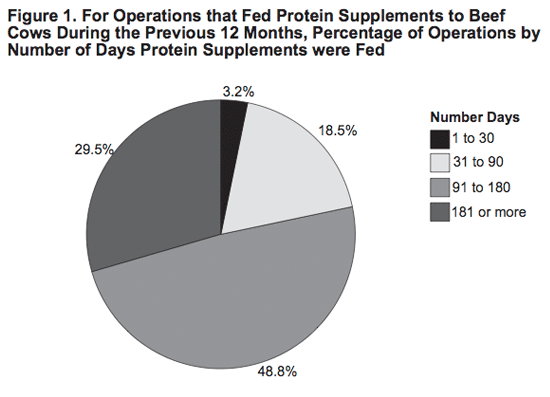
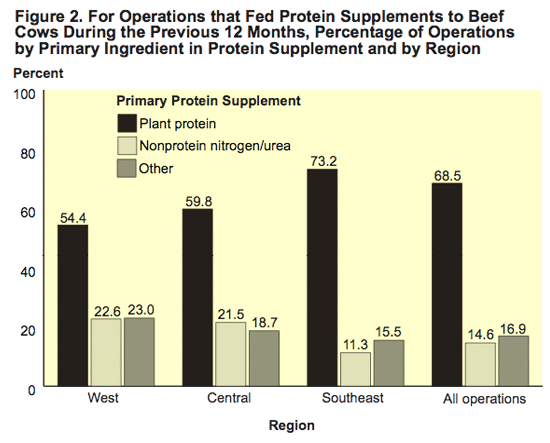
Energy supplements are fed to supply additional calories to beef cows when forage does not provide an adequate amount of energy. Many common protein supplements can also serve as energy supplements. The energy requirements of adult beef cows vary over the production cycle. Lactation is usually the time of highest demand for both protein and energy.
About one-half of operations (51.0 per cent) fed energy supplements to beef cows during the previous 12 months. Nearly one-half of operations that fed energy supplements to beef cows during the previous 12 months (45.3 per cent) fed the supplements for 91 to 180 days, and almost one of four operations (24.8 per cent) fed the energy supplements for 181 or more days (figure 3). The operation average number of days that beef cows were fed the supplements was 162.2 days (just over 5 months).
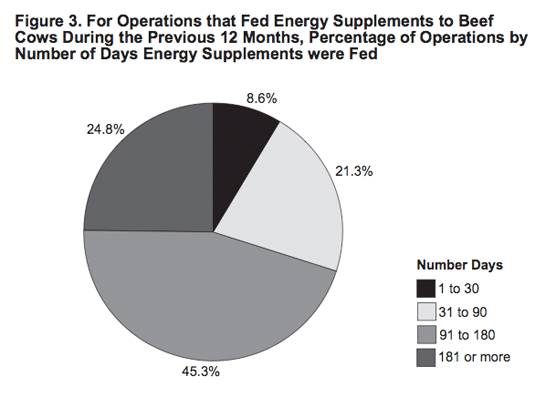
Corn contains a large amount of starch and has traditionally been an inexpensive choice for energy supplementation Caution should be exercised when using corn as an energy supplement, however, because forage intake will decrease if too much corn is fed. Corn was the primary energy supplement ingredient used on 57.5 per cent of operations that fed energy supplements. For the 42.5 per cent of operations that used energy supplements other than corn, common supplements were molasses, commercial products (e.g., blocks, pellets, liquids), corn byproducts (e.g., distillers grains), and oil seeds and meals (e.g., soybean or cottonseed). In the West region, energy supplements with a main ingredient other than corn predominated and were used on 74.3 per cent of operations that fed energy supplements (figure 4). Shorter growing seasons in some Western states and the cost of transporting corn from the Midwest may make corn less economical in the West region.
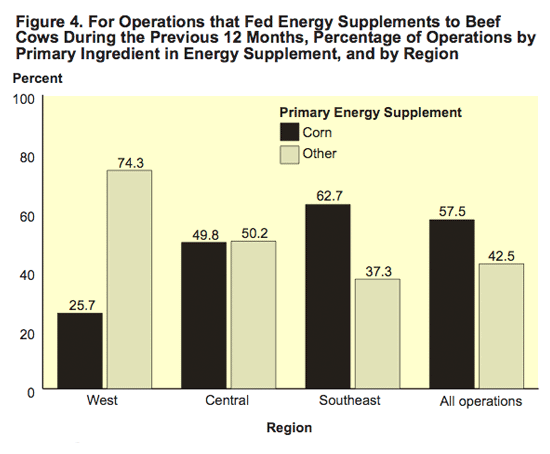
Supplemental roughage, such as harvested hay or corn stalks, is often provided for beef cows, particularly during winter months. Nearly all operations (97.1 per cent) used roughage supplements during the previous 12 months. Most operations that fed roughage during the previous 12 months fed the supplement for 91 to 180 days (65.8 per cent). Only 2.3 per cent of operations that fed roughage supplements to beef cows fed the supplements for less than 31 days (figure 5). A higher per centage of operations in the West region (8.3 per cent) fed roughage supplements for 1 to 30 days compared with operations in the Central region (0.1 per cent). The operation average number of days that beef cows were fed the supplement was 158.5 days (about 5 months). Producers were not asked about the primary ingredient in the roughage supplement.
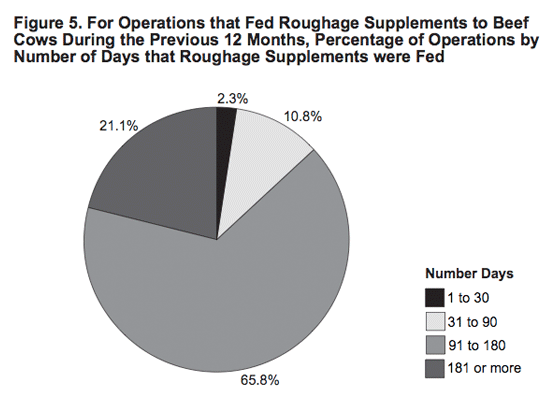
Resources, such as local university extension agents1 or veterinarians, are available to assist beef producers in designing an optimum feeding program. Appropriate supplements for beef cows should be selected based on the stage of production and the quality of the forage. Optimisation of feed rations and efficient use of supplements can result in greater profitability for the beef producer.
November 2010

